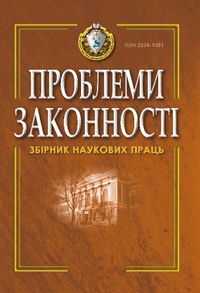History of international legal regulation of the issues related to the use of computer technologies
DOI:
https://doi.org/10.21564/2414-990x.134.80112Keywords:
cybersecurity, cyberspace, cyberattack, cybercrime, international information securityAbstract
The article studies the genesis of legal regulation of cybersecurity in international law, the definition of the place of the problem in relations between subjects of international law. Examples of high-profile cyberattacks that took place internationally are shown.
In recent years, human dependence on new technologies has grown rapidly. However, the use of such technologies also opens new ways to abuse via the Internet. With the development of new technologies cyberspace becomes as important space as land, air, water or space in which states compete for ensuring their national interests. Such space also attracts the attention of international terrorist groups, transnational organized crime etc.
A number of scientists devoted their papers to the subject of cybersecurity, among them A. Pazyuk, D. Dubov, A. Merezhko. Much more attention on the issue of cybersecurity research in international law was paid by foreign experts, including M. N. Schmitt, W. Heintschel von Heinegg, V. Boothby.
The article shows examples of international norms in cyberspace. Accordingly the foundations for further cooperation among the States were laid by the number of Resolutions of the General Assembly of the United Nations. One of the main documents in this field within the Council of Europe is ratified by 49 states Convention on Cybercrime in 2001 and Optional Protocol to the Convention of 2003. Within the EU the first document regulating cyberspace is Directive 95/46 of the European Parliament and of the Council of 24 October 1995 on the protection of individuals with regard to the processing of personal data and on the free movement of such data. In 2016 EU has adopted the EU Network and Information Security (NIS) Directive. As an example of doctrinal codification the Tallinn Manual on the International Law Applicable to Cyber Warfare was issued in 2013.
It is also mentioned in the article that states are actively working on preparing national legislation and adopting strategies for cybersecurity
It is noted that the issue of cybersecurity is becoming more acute problem not only at the national level and therefore requires expansion of international legal cooperation between subjects of international law to maintain peace and prevent solving cyber warfare, which may be accompanied by kinetic.
References
The Internet Organised Crime Threat Assessment (iOCTA), European Police Office (2014). www.europol.europa.eu. Retrieved from https://www.europol.europa.eu/sites/default/files/publications/europol_iocta_web.pdf.
Thomas, Reed. (2005). At the Abyss: An Insider’s History of the Cold War. Published in the United States. New York: Presidio press.
Byres, Eric J., Eng, P. (2009). Cyber Security And The Pipeline Control System. Lantzville, BC, Canada.
William, C. Major. (2009). Ashmore. Impact of Alleged Russian Cyber Attacks. School of Advanced Military Studies, United States Army Command and General Staff College, Fort Leavenworth, Kansas.
Schreier, Fred. (2015). On Cyberwarfare. DCAF HORIZON. Working paper No. 7.
Tikk, Eneken, Kaska, Kadri & Vihul, Liis. (2010). International Cyber Incidents: Legal Considerations, Tallinn, Cooperative Cyber Defense Centre of Excellence (CCD COE), 15–34. ccdcoe.org. Retrieved from https://ccdcoe.org/publications/books/legalconsiderations.pdf.
Melikishvili, Alexander. (2009). Recent Events Suggest Cyber Warfare Can Become New Threat (WMD Insights, December 2008/January 2009 Issue). www.wmdinsights.com. Retrieved from http://www.wmdinsights.com/I29/I29_G3_RecentEvents.htm.
Andryeyeva, O.M., Musiyenko, K. (2011). Kiberzbroya ta analiz yiyi destruktyvnoyi diyal’nosti na prykladi vplyvu virusu novoho pokolinnya STUXNET na irans’ku yadernu prohramu. Perspektyvy vidnosyn Ukrayiny zi USA, RF, EU & NATO v postkryzovomu sviti, 29–34 [in Ukrainian].
Resolution Adopted by the General Assembly 53/70. (1999). Developments in the Field of Information and Telecommunications in the Context of International Security. ccdcoe.org. Retrieved from https://ccdcoe.org/sites/default/files/documents/UN-981204-ITIS.pdf
Resolution adopted by the General Assembly 55/63. (2001). Combating the criminal misuse of information technologies. ccdcoe.org. Retrieved from https://ccdcoe.org/sites/default/files/documents/UN-001204-CriminalMisuseIT.pdf.
Resolution Adopted by the General Assembly 57/239. (2003). Creation of a global culture of cybersecurity. ccdcoe.org. Retrieved from https://ccdcoe.org/sites/default/files/documents/UN-021220-CultureOfCS.pdf
Konventsiya pro kiberzlochynnist’. (2007). Ofitsiynyy visnyk Ukrayiny vid 10.09.2007, No. 65, 107.
Convention on Cybercrime. (2016). Chart of signatures and ratifications of Treaty 185. Status as of 28.09.2016. Retrieved from https://www.coe.int/en/web/conventions/full-list/-/conventions/treaty/185/signatures?p_auth=yvTbDHWU.
Additional Protocol to the Convention on Cybercrime, concerning the criminalisation of acts of a racist and xenophobic nature committed through computer systems, CETS No. 189. (2006). The Council of Europe. conventions.coe.int. Retrieved from http://conventions.coe.int/Treaty/en/Treaties/Html/189.htm.
Rehlament Mizhnarodnoho soyuzu elektrozvyazku. (2012). Materialy Vsesvitnya konferentsiya elektrozvyazku MSE, Zheneva [in Ukrainian].
Directive 95/46/EC of the European Parliament and of the Council on the Protection of Individuals with Regard to the Processing of Personal Data and on the Free Movement of Such Data. (1995). Official Journal of the European Communities, No. L 281/31, 24 October.
Regulation (EC) No. 460/2004 of the European Parliament and of the Council of 10 March 2004 establishing the European Network and Information Security Agency. (2004). Official Journal L 077, 13/03/2004, 0001–0011.
European Commission. Network and Information Security (NIS) Directive. (2016). Digital Single Market, Digital Economy & Society, Directive (EU) 2016/1148. Retrieved from https://ec.europa.eu/digital-single-market/news/network-and-information-security-nis-directive.
Centre is the first International Military Organization hosted by Estonia. (2008). NATO Cooperative Cyber Defence Centre of Excellence, 28 October 2008. ccdcoe.org. Retrieved from https://ccdcoe.org/centre-first-international-military-organization-hosted-estonia.html.
Michael, N. (2013). Schmitt, the «International Group of Experts». Tallinn Manual on the International Law Applicable to Cyber Warfare. Cambridge University Press. issuu.com/nato_ccd. Retrieved from https://issuu.com/nato_ccd_coe/docs/tallinnmanual.
Cyber security strategy documents. NATO Cooperative Cyber Defence Centre of Excellence. Tallinn, Estonia. ccdcoe.orgю Retrieved from https://ccdcoe.org/cyber-security-strategy-documents.html.
Stratehiya natsional’noyi bezpeky Ukrayiny. (2015). Zatverdzhena Ukazom Prezydenta Ukrayiny vid 26.05.2015 № 287/2015. Ofitsiynyy visnyk Ukrayiny, 43 [in Ukrainian].
Framework for Cooperation on Cyber Defence Between NATO and Partner Nations. (2009). NATO/EAPC Unclassified, Document EAPC(C)D(2009)0010. uan.ua. Retrieved from http://uan.ua/sites/default/files/41210385dod2.pdf.
Michael, N. Schmitt. (2012). International Law in Cyberspace: The Koh Speech and Tallinn Manual Juxtaposed. Harvard Internatinal Law Journal, Vol. 54, December.
Dubov, D.V. (2016). Heopolitychne supernytstvo u kiberprostori yak chynnyk vplyvu na natsionalnu bezpeku Ukrayiny. Doctor’s thesis. Kyiv [in Ukrainian].
Pazyuk, A.V. (2015). Mizhnarodno-pravove rehulyuvannya informatsiynoyi sfery (teoretychni i praktychni aspekty). Doctor’s thesis. Kyiv [in Ukrainian].
Downloads
Published
How to Cite
Issue
Section
License
Copyright (c) 2016 Микола Валерійович Камчатний

This work is licensed under a Creative Commons Attribution 4.0 International License.










